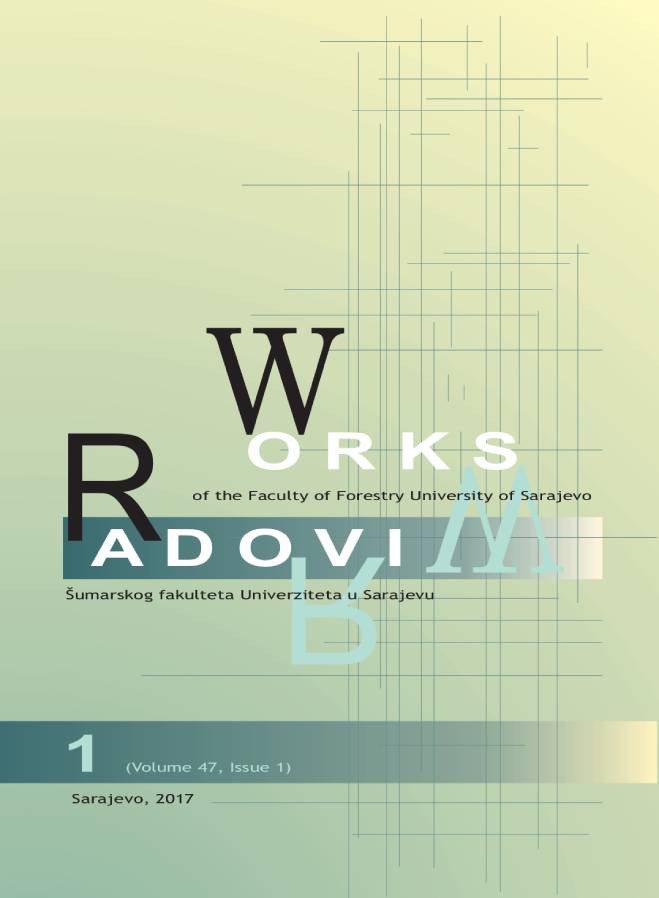ANTIOXIDANT CAPACITY AND PHENOLIC CONTENT OF FRAXINUS ORNUS L. AND FRAXINUS PENNSYLVANICA MARSCH. LEAVES AND BARK EXTRACTS
DOI:
https://doi.org/10.54652/rsf.2017.v47.i1.63Keywords:
F. ornus, F. pennsylvanica, phenols, DPPH, FRAPAbstract
UDK: 582.916.16:547.56
547.56:543.42
Total contents of phenols, flavonoids, phenolic acids and proanthocyanidins have been determined in methanolic extracts of Fraxinus ornus L. and Fraxinus pennsylvanica Marsch. leaves and branches bark. DPPH and FRAP assay were used in the determination of antioxidant capacity. F. ornus leaves had higher contents of flavonoids (13.08 mg RE g-1 DW) and proanthocyanidins (7.29 mg LCE g-1 DW) while the bark had higher contents of phenols (56.47 mg GAE g-1 DW), phenolic acids (14.32 mg CAE g-1 DW) and coumarins (94.81 mg CE g-1 DW). F. pennsylvanica leaves were richer in contents of phenols (25.73 mg GQE g-1 DW), flavonoids (2.87 mg CE g-1 DW and 5.13 mg RE g-1 DW), phenolic acids (14.60 mg CAE g-1 DW) and coumarins (20.01 mg CE g-1 DW) while the bark had more proanthocyanidins (6.88 mg CE g-1 DW). F. ornus leaves had lower contents of phenolic acids (11.09 mg CAE g-1 DW) than F. pennsylvanica leaves. Also, F. pennsylvanica bark had higher contents of flavonoids (1.25 mg RE g-1 DW) and proanthocyanidins (6.88 mg CE g-1 DW) than F. ornus bark. Antioxidant capacity for both species was higher for the leaves than the bark. Generally, F. ornus had better antioxidant capacity than F. pennsylvanica. Very high correlations were found between antioxidant capacity and phenols (r2= 0.9361-0.9805), flavonoids (r2= 0.9358-0.9876) and coumarins (r2= 0.9661-0.9938) in leaves. In bark, correlations were found for phenols (r2= 0.9744-0.9796) and coumarins (r2= 0.9757-0.9911).
References
ATMANI, D., CHAHER, N., BERBOUCHA, M., AYOUNI, K., LOUNIS, H., BOUDAOUD, H., DEBBACHE, N., ATMANI D. 2009: Antioxidant capacity and phenol content of selected Algerian medicinal plants, Food Chemistry, 112, 303-309.
AYOUNI, K., BERBOUCHA-RAHMANI, M., KIM, H.K., ATMANI, D., VERPOORTE, R., CHOI, Y.H. 2016: Metabolomics tool to identify antioxidant compounds of Fraxinus angustifolia leaf and stem bark extracts. Industrial Crops and Products, 88, 65-77.
BENZIE I.F. AND STRAIN J.J. 1996: The ferric reducing ability of plasma (FRAP) as a measure of "antioxidant power": the FRAP assay. Analytical Biochemistry, 239(1) 70-6.
CAUDULLO, G. AND DE RIGO, D. 2016: Fraxinus ornus in Europe: distribution, habitat, usage and threats. European Atlas of Forest Tree Species. San-Miguel-Ayanz, J. et al., Eds. Publication Office of the European Union, Luxembourg. ISBN: 978-92-79-36740-3.
GAWLIC-DZIKI, U. 2012: Dietary spices as natural effectors of lipoxygenase, xanthine oxidase, peroxidase and antioxidant agents. LTW-Food Science and Technology, 47, 138-146.
HAGERMAN, A., HARVEY-MUELLER, I., MAKKAR, H.P.S. 2000B: Quantification of tannins in tree foliage – a laboratory manual. FAO/IAEA, Vienna, pp.4-7.
IOSSIFOVA, T., KUJUMGIEV, A., IGNATOVA, A., VASSILEVA, E., KOSTOVA, I. 1994: Antimicrobial effects of some hydroxycoumarins and secoiridoids from the Fraxinus ornus bark. Pharmazie; 49, 298-299.
IORDACHE, T.A., VLASE, L., ISTUDOR, V., GIRD, C.E. 2013: Researches regarding obtaining selective extracts with hypoglycemiant properties from vegetal indigenous products (Cichorii Herba and Fraxini folium). Note III Phenolic compounds analysis from Fraxini folium. Farmacia, 61, (4), 625-631.
KOSTOVA, I. 2001: Fraxinus ornus L. Fitoterapia, 72, 471-480.
KOSTOVA, I. ,. BHATIA, S, GRIGOROV, P., BALKANSKY , S. , PARMAR, V.S. ,. PRASAD A.K , SASO, L. 2011: Coumarins as antioxidants. Current Medicinal Chemistry, 18, 3929-3951.
KOSTOVA, I. AND IOSSIFOVA, T. 2007: Chemical components of Fraxinus species. Fitotrapia, 78, 85-106.
MARINOVA, E.M., YANISHLIEVA, N.V., KOSTOVA, I.N. 1994: Antioxidative action og the ethanolic extract and some hydroxy coumarins of Fraxinus ornus bark. Food Chemistry, 1994; 51, 125-35.
NYKOLOV, N., IOSSIFOVA, T., VASSILEVA, E, KOSTOVA, I., STOEV, G. 1993: Reverse-phase high pressure liquid chromatographic analysis of hydroxycoumarins in plant extracts. Quantitative determination of hydroxycoumarins in Fraxinus ornus. Phytochemical Analysis, 4-86.
OMAR, S., LEMONNIER, B., JONES, N., FICKER, C., SMITH, M., NEEMA, C. 2000: Antimicrobial activity of extracts of eastern North American hardwood trees and relation to traditional medicine. Journal of Ethnopharmacology, 73(1-2), 161-170
ORDONEZ, A.A., GOMEZ, J.G., VATTUONE, M.A. AND ISLA, M.I. 2006: Antioxidant activities of Sechium edule swart extracts. Food Chemistry, 97, 452-458.
OSORIO, O.K. AND MARTINS, J.L.S. 2004: Determinacao de cumarina em extrato fluido tintura de guaco por espectrofotometria derivada de primeira ordem. Brazilian Journal of Pharmaceutical Sciences, 40(4), 481 486.
QUETTIER, D.C., GRESSIER, B., VASSEUR, J., DINE, T., BRUNET, C., LUYCK, M.C., CAYIN, J.C., BAILLEUL, F., TROTIN, F. 2000: Phenolic compounds and antioxidant activities of buckwheat (Fagopyrum esculentum Moench) hulls and flour. Journal of Ethnopharmacology, 118, 418-428.
ROYER, M., HOUDE, R., VIANO, Y., STEVANOVIC, T. 2012: Non-wood forest products based on extractives- A new opportunity for the Canadian Forest Industry. Part 1: Hardwood Forest Species. Journal of Food Research, 1(3), 8-45.
SANCEZ-MORENO, C., LARRAURI, J.A., SAURA-CALIXTO, F. 1998: A procedure to measure the antiradical efficiency of polyphenols. Journal of Science Food Agriculture, 76, 270-276.
SINGLETON, V.L., ORTHOFER, R., LAMUELA-RAVENTOS, R.M. 1974: Analysis of total phenols and other oxidation substrates and antioxidants by means of Folin-Ciocalteu reagent. Methods of Enzymology, 229, 152-178.
STEFANOVA, Z., NEYCHEV, H., IVANOVSKA, I., KOSTOVA, I. J. 1995: Effect of a total extract from Fraxinus ornus stem bark and esculin on zymosan- and carrageenan-induced paw oedema in mice. Journal of Ethnopharmacoly, 46, 101-106.
TAHIROVIĆ, A., BAŠIĆ, N. 2016: Determination of phenolic content and antioxidant capacity of Fraxinus excelsior L. and Fraxinus angustifolia Vahl. leaves and bark extracts. Works of the Faculty of Forestry University of Sarajevo, 46(1), 29-41.
VANDAL, A., ABOU-ZAID, M.M., FERRONI, G., LEDUC, L.G. 2015: Antimicrobial activity of natural products from the flora of Northern Ontario, Canada, Pharmaceutical Biology, 53(6), 800-806.
WESTWOOD, M., OLDFIELD, S., JEROME, D., ROMERO-SEVERSON, J. 2017: Fraxinus pennsylvanica. The IUCN Red List of Threatened Species: http://dx.doi.org/10.2305/IUCN.UK.2017-2.RLTS.T61918934A61919002.en.
WU, C.R., HUANG, M.Y., LIN, Y.T., JU, H.Y., CHING, H. 2007: Antioxidant properties of Cortex Fraxini and its simple coumarins. Food Chemistry, 104, 1464-71.



















